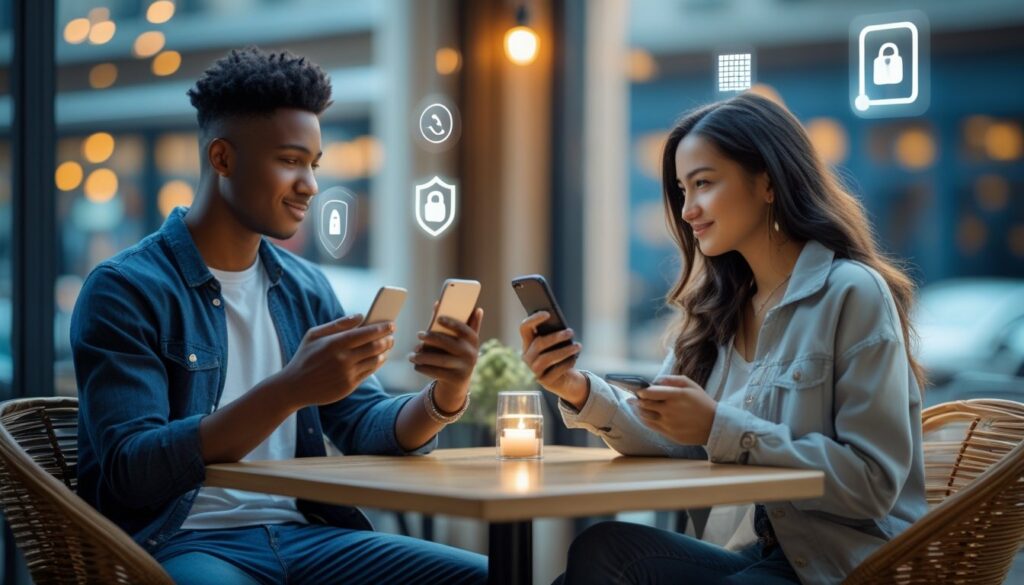Many people struggle to feel close to others while also feeling safe and secure. You might worry that opening up will make you vulnerable or that protecting yourself will push people away.
Healthy relationships require you to create emotional safety while building meaningful connections with others.

When you feel emotionally safe, you can be yourself without fear of judgment or rejection. This safety helps you share your thoughts and feelings more freely.
You also need connection to feel fulfilled and happy in your relationships. Finding this balance takes practice and understanding.
You need to set boundaries while staying open to others. This process includes building trust, showing empathy, and communicating clearly about your needs.
Key Takeaways
- Emotional safety and meaningful connection can exist together when you balance both needs.
- Building trust through clear communication and empathy helps create secure relationships.
- Setting healthy boundaries while staying open to others is essential for lasting connections.
The Importance of Balancing Safety and Connection

Safety gives you protection and stability. Connection brings meaning and support to your life.
Finding the right balance between these needs helps you build stronger relationships without putting yourself at risk.
Defining Safety and Connection
Safety means feeling secure and protected from harm. This includes physical safety, like being free from danger, and emotional safety, which means feeling comfortable to be yourself.
Connection refers to the bonds you form with other people. These relationships give your life meaning and support.
Strong connections help you feel understood and valued. Physical safety protects your body and health, while emotional safety protects your feelings and mental well-being.
Both types work together to create a secure foundation for your life. Connection grows through trust, empathy, and understanding.
When you connect with someone, you feel less alone in the world. Sharing experiences builds these bonds.
Why Balance Matters in Modern Life
You need both safety and connection to live a fulfilling life. Too much focus on safety can leave you isolated and lonely.
Too much focus on connection without safety can put you in harmful situations. Modern technology makes this balance even more important.
Social media lets you connect with many people quickly. But it also creates new safety risks like cyberbullying and online predators.
Your mental health depends on finding the right balance. People with strong social connections live longer and feel happier.
But these connections must rest on a foundation of safety and trust.
Why balance helps you:
- Reduces stress and anxiety
- Improves your relationships
- Builds confidence in social situations
- Protects you from harmful people
Challenges of Finding Balance
Many people struggle to balance safety and connection. Some become too cautious and avoid forming new relationships.
Others ignore warning signs and trust people too quickly. Past experiences can make balance harder to achieve.
If you’ve been hurt before, you might build walls that keep everyone out. This protects you but also blocks positive connections.
Fear often drives people toward one extreme or the other. You might fear rejection and avoid reaching out to others.
Or you might fear being alone and ignore red flags in relationships.
Common challenges include:
- Overthinking social situations
- Difficulty reading social cues
- Past trauma affecting new relationships
- Pressure to connect on social media
Learning to show empathy while maintaining boundaries takes practice. You can care about others without sacrificing your own well-being.
Establishing Emotional Safety in Relationships

You create emotional safety by building a space where you and your partner can share feelings without fear of judgment or rejection. This foundation requires understanding how safety affects connection and setting clear boundaries that protect both people.
The Role of Emotional Safety
Emotional safety forms the bedrock of healthy relationships. When you feel emotionally safe, you share your true thoughts and feelings more easily.
Without this safety, you might hide parts of yourself or walk on eggshells around your partner. This creates distance instead of closeness.
Emotionally safe relationships allow empathy to grow naturally. You can express hurt, joy, fear, or excitement without worrying about your partner’s reaction.
Couples who feel emotionally safe often experience higher relationship satisfaction and better conflict resolution skills. They also build a stronger emotional connection.
When you feel emotionally safe, your nervous system can relax. You don’t need to stay alert for threats or criticism from your partner.
This relaxed state makes it easier to connect deeply. You can be yourself without pretending or hiding important parts of who you are.
Building Trust and Vulnerability
You build trust through small, consistent actions over time. Keep promises, show up when you say you will, and respond with care when your partner shares something personal.
Vulnerability means sharing your real feelings, even when it feels scary. This might include admitting mistakes, expressing needs, or talking about past hurts.
EFT (Emotionally Focused Therapy) shows that couples who practice healthy vulnerability create stronger bonds. When you share something vulnerable and receive acceptance, trust deepens.
Start with small acts of vulnerability:
- Share a worry about work
- Admit when you feel insecure
- Express appreciation for specific things your partner does
Your partner’s response to vulnerability matters. Do they listen without trying to fix everything? Do they show empathy instead of judgment?
When someone meets vulnerability with understanding, trust grows. You feel safer sharing more, which builds stronger connection over time.
Boundaries as Foundations of Safety
Boundaries are guidelines that help you feel secure while staying connected to your partner. They aren’t walls that keep people out.
Healthy boundaries might include:
- Communication rules (no yelling during arguments)
- Time boundaries (respecting each other’s need for alone time)
- Physical boundaries (asking before hugging when someone is upset)
Communicate your boundaries clearly. Your partner can’t respect limits they don’t know about.
Respect your partner’s limits as well. If they say they need space to process feelings, honor that request.
When you and your partner respect boundaries, you both feel safer being open. You know your needs and limits matter.
Boundaries can change over time. What feels comfortable today might shift as your relationship grows.
Honoring Autonomy While Fostering Connection

True connection happens when you respect each person’s independence while building strong bonds. This means supporting individual choices, understanding different needs, and blending personal freedom with closeness.
Supporting Individual Autonomy
You can build stronger relationships by encouraging others to make their own decisions. When you respect someone’s choices, you show that you value them as a person.
Supporting autonomy means stepping back when someone needs space. It also means asking before giving advice or help.
Key ways to support autonomy:
- Ask “What would you like to do?” instead of telling them what to do
- Listen without trying to fix their problems
- Respect their “no” without arguing
- Give them time to make decisions
You might worry that giving people freedom will push them away. But the opposite is true.
When you trust someone’s judgment, they feel more comfortable being close to you. Most people pull away from controlling behavior.
Recognizing Individual Needs
Everyone has different needs for connection and space. Some people need lots of social time, while others need quiet time alone to recharge.
Notice what each person needs. Watch for signs that someone feels overwhelmed or lonely.
Pay attention to their energy levels and mood changes.
Common signs someone needs space:
- They seem tired or stressed
- They give short answers
- They avoid eye contact
- They say they’re “fine” but seem upset
Signs someone needs more connection:
- They reach out more often
- They seem sad or withdrawn
- They ask for help with small things
- They bring up past memories
Empathy helps you understand these different needs. Try to see things from their point of view.
Integrating Autonomy With Relational Closeness
You don’t have to choose between giving someone freedom and staying close. The best relationships have both autonomy and connection.
Start by talking openly about your needs. Tell people when you need space or when you want to spend time together.
Create agreements that work for everyone. Maybe you check in with each other once a week, or you have a signal that means “I need alone time right now.”
Ways to balance freedom and closeness:
- Schedule regular check-ins
- Create “together time” and “apart time”
- Share your feelings without expecting them to fix things
- Support each other’s goals and interests
Healthy relationships change over time. Someone might need more space during stressful periods and want more connection during happy times.
Stay flexible while showing you care. When you honor both autonomy and connection, your relationships become stronger and more honest.
Empathy as a Bridge Between Safety and Connection

When you practice empathy in your daily interactions, you create emotional attunement that helps others feel both understood and secure. This skill allows you to validate feelings while maintaining healthy boundaries.
Practicing Empathy in Communication
Empathy starts with how you listen to others. When someone shares their feelings, try to understand their perspective without immediately offering solutions or judgment.
Active listening techniques include:
- Making eye contact and nodding
- Asking clarifying questions like “How did that make you feel?”
- Reflecting back what you heard: “It sounds like you felt frustrated when…”
Show empathy through your body language. Lean in slightly when someone talks, keep your arms uncrossed, and put your phone away.
Avoid these common mistakes:
- Saying “I know exactly how you feel”
- Jumping to fix the problem right away
- Comparing their situation to yours
When you practice empathy, you build trust. People feel safer opening up to you because they know you’ll listen without criticism.
Emotional Attunement and Validation
Emotional attunement means tuning into someone’s emotional state and responding appropriately. You don’t have to agree with their feelings, but you can acknowledge them.
Validation phrases that work:
- “That sounds really difficult”
- “Your feelings make sense given what happened”
- “I can see why you’d feel that way”
You can validate someone’s emotions while keeping your own boundaries. For example, you might say: “I understand you’re upset, and I want to help you work through this calmly.”
Signs you’re emotionally attuned:
- You notice changes in their tone or mood
- You sense when they need space or support
- You respond to their emotional needs in the moment
This kind of connection creates safety because people feel heard and understood. They’re more likely to trust you and share openly when they know you care about their emotional experience.
Balancing Safety and Connection in Digital Spaces

Digital spaces give you unique opportunities to connect with others while maintaining personal boundaries. Use technology mindfully, set clear limits, and focus on building genuine relationships online.
Mindful Technology and Social Media Use
Your relationship with technology affects your safety and how you connect with others. Social media can bring people together, but careless use can put you at risk.
Check your privacy settings on all platforms. Know who can see your posts and personal information.
This step protects your safety while still letting you connect meaningfully with others.
Set time limits to stay in control. Choose specific hours for social media each day.
This helps prevent endless scrolling that can harm your mental health.
Try these daily practices:
- Check notifications only 2-3 times a day
- Turn off non-essential alerts
Use app timers to track your usage. Keep devices out of the bedroom.
Notice how each platform makes you feel. If a site causes stress or anxiety, take a break or unfollow certain accounts.
Setting Digital Boundaries
Healthy boundaries protect your autonomy and keep relationships strong. You have the right to control your digital experience and decide how others interact with you online.
Set clear rules about what you will and won’t share. Keep personal details like your location, financial information, and family matters private.
Share your boundaries with friends and family so they understand your limits.
Block or unfriend people who make you uncomfortable. Trust your instincts when someone’s behavior feels off.
Set communication expectations:
- Respond to messages when it works for you
- Don’t feel pressured to be available all the time
Use “Do Not Disturb” features during personal time. Be honest about your availability.
Saying “no” to digital requests is always okay. You control your online presence.
Fostering Authentic Connection Online
Real connection happens when you are genuine and present in your digital interactions. Focus on quality conversations, not just collecting followers or likes.
Share content that reflects your true interests and values. People connect with authenticity, not perfect images.
Ask questions and show real interest in others’ lives.
Choose video calls when possible. Face-to-face conversations help you read body language and hear tone, which build deeper understanding.
Join online communities based on your hobbies or interests. These groups give you shared experiences and easy conversation starters.
Look for communities with active moderation to stay safe.
Practice active listening in digital conversations. Read messages carefully before replying.
Ask follow-up questions to show you care about what others say.
Small gestures matter online too. Remember important events in friends’ lives, celebrate their achievements, and offer support during tough times.
These actions strengthen real relationships through digital means.
Emotionally Focused Therapy (EFT) Approaches

EFT helps you understand how attachment patterns shape your relationships. This approach gives you tools to heal old wounds.
EFT focuses on building secure emotional bonds through empathy and deeper connection with your partner.
Attachment Theory and Secure Bonds
Attachment theory explains how your early relationships shape how you connect with others. When you feel safe and secure, you can share your feelings openly.
Secure attachment means you trust your partner will be there for you. You don’t worry all the time about being abandoned or rejected.
This creates a strong foundation for your relationship.
Key signs of secure attachment:
- You communicate needs clearly
- You comfort each other during stress
You feel safe being vulnerable. You trust your partner’s intentions.
When both partners feel secure, you handle conflict better. You are more likely to listen with empathy instead of getting defensive.
This helps your connection grow stronger over time.
Healing Attachment Wounds with EFT
Many people carry attachment wounds from past relationships or childhood. These wounds can make you feel unsafe even with a loving partner.
EFT helps you identify and heal these old hurts.
A therapist will help you recognize your attachment patterns. Maybe you shut down during conflict, or chase your partner when they need space.
Common attachment wounds include:
- Fear of abandonment
- Difficulty trusting others
You may feel unworthy of love or avoid emotional intimacy.
Healing involves sharing your deeper emotions with your partner. This can feel scary at first.
When your partner responds with empathy and understanding, you create new positive experiences.
Practice expressing your needs in ways your partner can hear. This builds the secure bond you both want.
EFT Tools for Lasting Balance
EFT offers practical tools to help you balance safety and connection. These techniques help you stay emotionally open while you protect your well-being.
Accessing primary emotions is a core EFT skill. You learn to notice the hurt or fear beneath your anger, which helps your partner understand your real needs.
The hold me tight conversation gives you a way to share vulnerable feelings. You and your partner take turns expressing your emotions and listening without judgment.
This process builds empathy between you. It helps both of you feel heard and supported.
Creating new bonding experiences lets you replace old negative patterns. You might plan regular check-ins or start special rituals that strengthen your connection.




